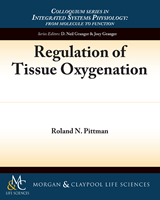NCBI Bookshelf. A service of the National Library of Medicine, National Institutes of Health.
Pittman RN. Regulation of Tissue Oxygenation. San Rafael (CA): Morgan & Claypool Life Sciences; 2011.
The regulation of tissue oxygenation is based at the start from the ability of the respiratory system to fully oxygenate the arterial blood which the heart then delivers to the peripheral tissues. The need for different levels of respiration varies with the physiologic state of the organism (e.g., sleep, excitement, exercise). The respiratory system must try to maintain constant levels of O2, CO2 and H+ in the arterial blood which then ensures relatively constant levels of these important substances in the interstitial fluid. For O2, one needs an adequate supply to meet cellular metabolic requirements. For CO2 and H+, one needs to maintain the acid–base status of the body's cells. The respiratory system provides a rapid, but usually incomplete, compensation for acid–base disturbances through altered PCO2. Changes in the levels of O2, CO2 and H+ in the blood cause compensatory changes in the level of ventilation [6,10,54,113].
RESPONSE TO ALTERED OXYGEN
The response of ventilation to altered alveolar PO2 is displayed in the curves shown in Figure 7.
The following features of these curves are noteworthy. As alveolar PO2 decreases below a threshold of about 50 mm Hg at normal PCO2, ventilation increases. At a given alveolar PO2, ventilation depends on alveolar PCO2. Ventilation increases with increasing PCO2. Thus, increased CO2 potentiates the response to decreased PO2. For normal alveolar PCO2, no increase in ventilation is observed until alveolar PO2 falls below about 50 mm Hg. Because arterial blood is still highly saturated with oxygen (recall the oxygen dissociation curve, SO2 ≈ 80% when PO2 is about 50 mm Hg), there is no great need for sensitivity to PO2 above about 50 mm Hg. In normal situations, the hypoxic stimulus is not very important. On ascent to high altitude, however, it takes on considerable significance. For example, at an elevation of 10,000 ft, barometric pressure is about 550 mm Hg, yielding an inspired PO2 of about 100 mm Hg and a PAO2 of about 50 mm Hg.
CENTRAL AND PERIPHERAL RESPIRATORY CHEMORECEPTORS
The central chemoreceptor response to hypoxia actually depresses ventilation, presumably by depressing oxidative metabolism in neural tissue. The peripheral chemoreceptors are located in the carotid (carotid sinus) and aortic bodies (aortic arch). The carotid bodies respond to arterial hypoxia by increasing the firing rate from the carotid sinus nerve. The carotid bodies are connected to the respiratory centers in the brainstem, and all of the respiratory response from peripheral chemoreception originates in them. The carotid bodies have high blood flow and are not sensitive to CO or anemia. The aortic bodies are connected to the cardiovascular centers in the brainstem, and they are responsible for the cardiovascular response to respiratory-linked chemical factors in the arterial blood. The aortic bodies have lower blood flow than do the carotid bodies, and they are sensitive to CO and anemia. The carotid bodies are small (1–2 mg) organs with an enormous blood flow (1–2 l per min per 100 g tissue). Their O2 consumption relative to blood flow is negligible, resulting in a small arteriovenous O2 difference. They continuously sample arterial blood. The mechanism of peripheral chemoreceptor oxygen sensitivity appears to involve PO2 directly rather than [O2] or SO2. The responses by the central and peripheral respiratory chemoreceptors can be summarized by stating that the sensed variable is arterial PO2 (PaO2); when it falls below 50 mm Hg, the central chemoreceptors give a non-specific metabolic response that depresses ventilation, whereas the peripheral chemoreceptors stimulate ventilation. Thus, all of the stimulatory response to hypoxia resides in the peripheral chemoreceptors. Elevation of PaO2 above normal (∼100 mm Hg) generally has no effect on ventilation since the respiratory chemoreceptors appear to be insensitive to changes in PaO2 above about 50–60 mm Hg.
- Chemical Regulation of Respiration - Regulation of Tissue OxygenationChemical Regulation of Respiration - Regulation of Tissue Oxygenation
Your browsing activity is empty.
Activity recording is turned off.
See more...

